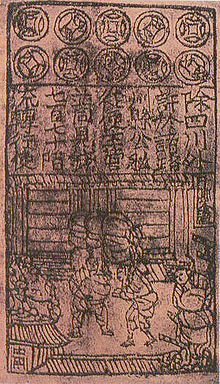Ilmu dan teknologi di dinasti Song
Dinasti Song (Hanzi: 宋朝; 960–1279 M) menyumbang beberapa kemajuan teknologi paling signifikan dalam sejarah Tiongkok, banyak di antaranya berasal dari para negarawan berbakat yang dirancang oleh pemerintah melalui ujian kenegaraan.

 |
| Sejarah sains dan teknologi di Tiongkok |
|---|
| Menurut subjek |
| Menurut era |
Kecerdasan teknik mesin canggih memiliki tradisi panjang di Tiongkok. Insinyur Song, Su Song mengakui bahwa dia dan orang-orang sezamannya membangun berdasarkan prestasi orang-orang kuno seperti Zhang Heng (78–139), seorang astronom, penemu, dan master roda gigi mekanis awal.[1] Penerapan cetak huruf lepas membantu perkembangan penggunaan cetak blok kayu yang sudah tersebar luas untuk mendidik dan memikat para siswa dan massa Konfusian. Penerapan senjata baru menggunakan bubuk mesiu memungkinkan Song untuk menangkal musuh-musuh militannya—Liao, Xia Barat, dan Jin dengan senjata seperti meriam—sampai keruntuhannya di tangan pasukan Mongol Kublai Khan pada akhir abad ke-13.
Kemajuan penting dalam teknik sipil, nautika, dan metalurgi dicapai dalam masa Tiongkok Song, serta pengenalan kincir angin ke Tiongkok selama abad ketiga belas. Kemajuan-kemajuan ini, beserta dengan pengenalan uang cetakan kertas, membantu merevolusi dan menyokong ekonomi Dinasti Song.
Polimatik dan teknik mesin
Lihat pula
Referensi
Kutipan
Sumber
- Bowman, John S. (2000). Columbia Chronologies of Asian History and Culture. New York: Columbia University Press.
- Ebrey, Walthall, Palais, (2006). East Asia: A Cultural, Social, and Political History. Boston: Houghton Mifflin Company.
- Ebrey, Patricia Buckley (1999). The Cambridge Illustrated History of China. Cambridge: Cambridge University Press. ISBN 0-521-43519-6 (hardback); ISBN 0-521-66991-X (paperback).
- Embree, Ainslie Thomas (1997). Asia in Western and World History: A Guide for Teaching. Armonk: ME Sharpe, Inc.
- Gernet, Jacques (1982). A History of Chinese Civilization. Cambridge: Cambridge University Press.
- Hartwell, Robert (1966). Markets, Technology and the Structure of Enterprise in the Development of the Eleventh Century Chinese Iron and Steel Industry. Journal of Economic History 26.
- Levathes (1994). When China Ruled the Seas. New York: Simon & Schuster. ISBN 0-671-70158-4.
- Morton, Scott and Charlton Lewis (2005). China: Its History and Culture: Fourth Edition. New York: McGraw-Hill, Inc.
- Needham, Joseph (1986). Science and Civilisation in China: Volume 3; Mathematics and the Sciences of the Heavens and the Earth. Cambridge: Cambridge University Press.
- Needham, Joseph (1986). Science and Civilisation in China: Volume 4, Physics and Physical Technology, Part 1, Physics. Cambridge: Cambridge University Press.
- Needham, Joseph (1986). Science and Civilisation in China: Volume 4, Physics and Physical Technology, Part 2, Mechanical Engineering. Cambridge: Cambridge University Press.
- Needham, Joseph (1986). Science and Civilisation in China: Volume 4, Physics and Physical Technology, Part 3, Civil Engineering and Nautics. Cambridge: Cambridge University Press.
- Needham, Joseph (1986). Science and Civilisation in China: Volume 5, Chemistry and Chemical Technology, Part 1, Paper and Printing. Cambridge: Cambridge University Press.
- Needham, Joseph (1986). Science and Civilisation in China: Volume 5, Chemistry and Chemical Technology, Part 7, Military Technology, the Gunpowder Epic. Cambridge: Cambridge University Press.
- Partington, James Riddick (1960). A History of Greek Fire and Gunpowder. Cambridge: W. Heffer & Sons Ltd.
- Sivin, Nathan (1995). Science in Ancient China. Brookfield, Vermont: VARIORUM, Ashgate Publishing.
- Unschuld, Paul U. (2003). Nature, Knowledge, Imagery in an Ancient Chinese Medical Text. Berkeley: University of California Press.
- Wagner, Donald B. "The Administration of the Iron Industry in Eleventh-Century China", Journal of the Economic and Social History of the Orient (Volume 44 2001): 175-197.
- Wright, David Curtis (2001) The History of China. Westport: Greenwood Press.
- Wu, Jing-nuan (2005). An Illustrated Chinese Materia Medica. New York: Oxford University Press.
Pranala luar
- Bubuk mesiu dan "senjata api"
- Chinese Fire Arrows
- The History of Early Fireworks and Fire Arrows
- Gunpowder and Firearms in China
- Chinese Siege Warfare: Mechanical Artillery & Siege Weapons of Antiquity
- Lainnya